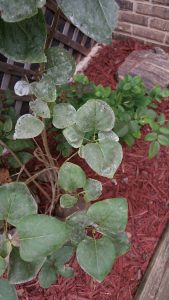
Powdery mildew on lilac leaves.
Photo credit: C.B.
Q. Is there any way you could help in figuring out what is wrong with our lilac? – C.B. via email.
A. Lilacs are quite susceptible to a fungal disease called powdery mildew, which causes a grayish-white, powdery coating of spores and fungal structures on the surface of leaves, stems, flower petals and fruit.
According to the Purdue Plant and Pest Diagnostic Laboratory, the best method of control is prevention. Practices that will decrease the severity of powdery mildew include avoiding planting cultivars highly susceptible and alleviating high humidity by spacing plants far enough apart to allow good air movement to quickly dry the foliage. Although chemical control is seldom warranted in the home landscape for powdery mildew, preventative fungicide sprays are available for use on prized ornamentals that require protection.

Powdery mildew on a lilac shrub.
Photo credit: C.B.
The siting of your plant looks like it might suffer from lack of good air circulation, being in the corner, and also not much area for good root growth. Is this also a shady location? If so, replacing the lilac with a better adapted species might be the best option.
More information on powdery mildew can be found at
*https://www.ppdl.purdue.edu
/PPDL/weeklypics/7-27-15.html and Purdue Extension bulletins:
*https://www.extension.
purdue.edu /extmedia/bp/bp-5-w.pdf
*https://www.extension.
purdue.edu /extmedia/bp/id-414-w.pdf
Q. I am a loyal reader of your “Green Thumb.” I’m having trouble with several peony bushes (two out of 12). The stems turn black and the foliage dies. Is this something that will spread to the other peonies? Some of my beds are crowded and don’t get good air flow, but these peonies are on the border and not at all crowded. – S.S., English, Indiana.
A. Peonies are susceptible to a couple of common fungal diseases – leaf blotch and botrytis blight. Leaf blotch is also called red spot or measles. The numerous common names reflect the various symptoms, including blotches on leaves and stems and small red spots (measles). The fungus overwinters on plant debris and tends to be present every year once it occurs.
Botrytis blight also causes blackening of leaves, stems and flowers and is especially prevalent in wet seasons, so it would be a prime suspect this year. There are a few fungicides labeled for use on peonies for this disease, but they would have to be applied early and often to protect the leaves from infection rather than wait until after the disease is present.
For both diseases, good sanitation is the best prevention strategy, including removal of infected foliage as it appears. Fall-clean by removal of plant tops and fallen leaves at the end of the season can help lessen the amount of overwintering inoculum.
When irrigating, use drip or soaker hoses rather than overhead, or water early in the morning so the foliage can dry quickly. Good air circulation will also help – dig up and divide overcrowded plantings.
More information on peony diseases can be found at:
* https://www.ppdl.purdue.edu/PPDL/expert/peonies_spots.html
* https://www.ppdl.purdue.edu/PPDL/expert/Peonies.html